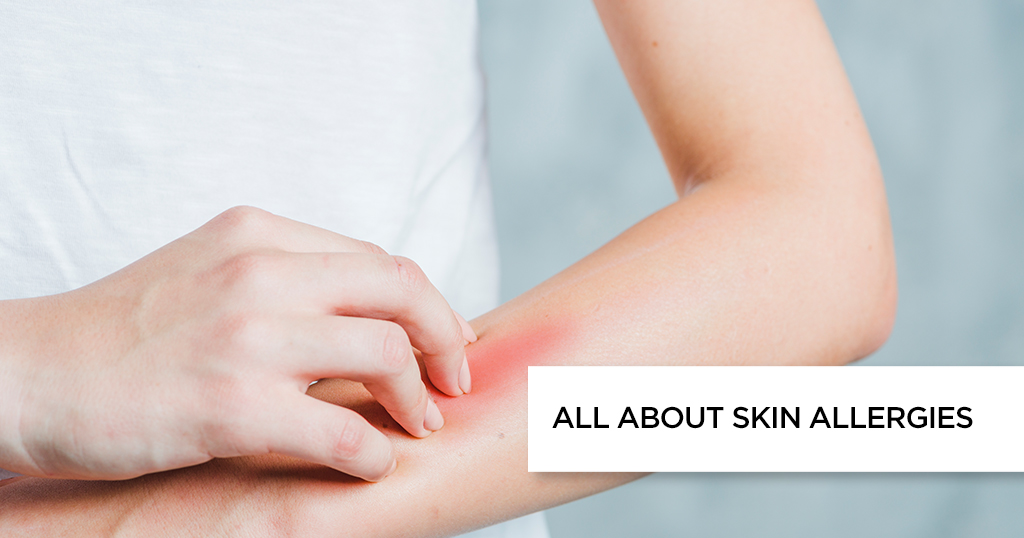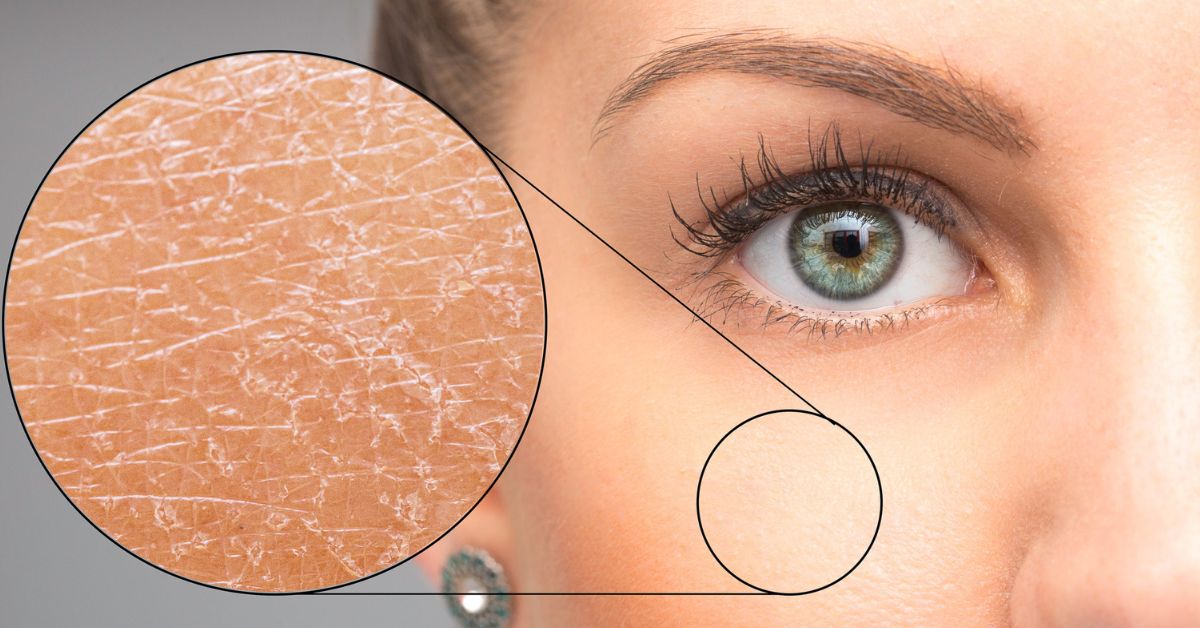Skin Allergy – Types, Causes, Symptoms and Treatment


Overview
When the immune system reacts to something harmless, causing an allergic reaction is a skin allergy. Different allergens can cause allergies, such as pollen, plants, food, certain medications, etc. Itching, bumps, redness, and other skin conditions are common. Sometimes, their cause may not be easily identifiable. Sometimes, it can be due to medical conditions like chickenpox or measles. An allergist can diagnose the cause of an allergy. There are many preventive methods and treatment options available to treat allergies.
What is Skin Allergy?
Skin allergy is a condition where the immune system reacts to certain harmless substances identifying them as allergens. Skin experiences a reaction when it comes in contact with a particular substance that it is allergic to. Exposure can be by any means direct contact, ingestion, inhalation, or injection. Medically, skin allergies of all kinds are called hypersensitivity reactions. The one that manifests as an immediate reaction is called a Type 1 hypersensitivity reaction, and the one with a delayed onset is called Type 4 hypersensitivity reaction.
What are the Types of Skin Allergies?
There are some types of skin allergies; a few of them include:
- Urticaria or hives
- Atopic dermatitis
- Contact allergic dermatitis
- Angioedema (Swelling)
Urticaria or Hives: Urticaria, commonly known as hives, is a Type 1 hypersensitivity reaction caused by antibody IgE (Immunoglobulin E). It can occur due to various antigens that occur internally (e.g., from an infection inside the body) or occur from an external source.
Internal triggers that cause hives include:
- Bacterial infections like upper respiratory tract infections or urinary tract infection
- Infestations such as amoebiasis or giardiasis
- Systemic diseases like systemic lupus erythematosus referred to as SLE (a long-term autoimmune disorder)
External triggers that cause hives include:
- Inhalants – pollen, animal dander, plant hair
- Food – eggs, seafood, meat, and vegetables
- Drugs – penicillin and over-the-counter painkillers
- Physical agents – heat, cold, or injury
Symptoms of Hives
Some of the symptoms of hives include:
- The dermis (the deeper layer of the skin) becomes swollen due to the expansion of blood vessels.
- Lips get swollen
- Itching is common
- May notice respiratory symptoms, such as a runny nose, wheezing, and breathing difficulty along with skin manifestations.
- May notice heaviness in the chest and abdominal pain
Diagnosis of Hives
The physician will ask for a detailed history of the onset, type of symptoms, and duration. Routine tests like blood, urine, and stool examinations are also conducted. Skin tests may also be advised.
Treatment for Hives
Prevention is better than cure — this old adage holds true in the case of hives.
If the allergen is known to you, avoid it at all costs. For example, if artificial jewelry containing nickel triggers allergy, choose your jewelry with care. If you know you are likely to break out due to exposure to the allergen, take an antihistamine (anti-allergic). You can choose an over-the-counter medication containing chlorpheniramine or diphenhydramine.
If a very small area of the skin is affected, a steroid ointment (hydrocortisone) applied locally will help. You could also try calamine lotion as it has a soothing effect on irritated skin.
Cold compresses and ice applications offer a temporary solution. Avoid hot water in the case of hives, as it worsens the condition.
If the cause of hives is stress or emotional turmoil, try a tea brew of peppermint or chamomile to calm the nerves.
Preventive Measures for Hives
Some of the preventive measures for hives include:
- Identify your triggers, such as pet danders, pollen, dust, certain food items, and medications, and avoid them as much as possible.
- Wear loose-fitting outfits made up of cotton.
- Take your medications as prescribed by your doctor.
- Soothe your skin by taking baths and applying moisturizer as and when needed.
Atopic Dermatitis: If you have atopic dermatitis, stay away from irritants such as dust, cigarette smoke, woolen, and synthetic fibers.
What is Atopic Dermatitis?
‘Dermatitis’ means inflammation of the skin, and the word ‘atopic’ refers to hereditary diseases and often occur together.
Atopic dermatitis is a skin allergy where a person experiences increased reactions to common and mild environmental factors. In atopic dermatitis, the person experiences severe itching and inflammation of the skin; this is also referred to as eczema (a general term used for many skin inflammation types). Atopic dermatitis often occurs with other atopic disorders like hay fever, allergic rhinitis (allergic cold), and asthma.
Causes of Atopic Dermatitis
It is commonly observed in children and is not very common in adults.
- A combination of genetic and environmental factors.
- Chemicals found in soaps and cosmetics, synthetic or woolen clothes, and extreme temperatures.
- Emotional factors such as stress are also known to trigger this skin allergy.
Symptoms of Atopic Dermatitis:
- Dry, itchy, and red skin constitute the most common symptoms. A person with atopic dermatitis experiences severe itching. Scratching in response to it only worsens the skin inflammation, in addition to worsening the itch itself.
- In infants, acute eczema characterized by reddish raised lesions, crusting, and weeping is seen on the face, scalp, chest, and limbs. In severe cases, it extends to other areas too.
- In children, acute eczema with skin pigmentation usually occurs, especially behind the knees and elbows.
- In adolescents and adults, chronic eczematous lesions like thickening and prominent markings are seen.
Common skin irritants for those with Atopic Dermatitis
Some of the skin irritants include:
- Wool, animal fur, or synthetic fibers
- Soaps and detergents
- Irritants like mineral oil, chlorine
- Dust
- Cigarette smoke
Diagnosis of Atopic Dermatitis
Atopic dermatitis can be easily diagnosed through a physical examination. The characteristic features of the condition, such as severe itching, rashes in characteristic locations like the folds of the knees and elbows, family history or history of atopy, and recurring dermatitis, can help confirm it.
Treatment of Atopic Dermatitis
- Avoid contact with the allergen if known.
- Application of steroid creams on externally affected areas is recommended.
- Initially, it will be necessary to use a potent steroid to break the itch-scratch-itch cycle.
- In case of long-term usage, you should use a milder steroid cream like hydrocortisone.
Preventive measures for Atopic Dermatitis
Some of the preventive measures of atopic dermatitis include:
- Protect your skin from dryness. Make sure to apply moisturizer at least two to three times a day.
- Identify your triggers and avoid them as much as possible.
- Do not take long showers, and make sure to use lukewarm water.
- The American Academy of Dermatology (AAD) recommends taking a bleach bath to prevent flashes of skin rashes.
- Make sure to use mild soaps.
- Contact Allergic Dermatitis
- Artificial or costume jewelry can cause or trigger dermatitis in some; if you are one of them, it would be best to avoid wearing it.
What is contact Allergic Dermatitis?
Contact allergic dermatitis, called CAD for short, is inflammation of the skin due to exposure to an irritant or allergy-causing substance. It is classified as a Type 4 hypersensitivity reaction. It is a listed occupational disease in most parts of the world, as those in chemical, paint, and plastic industries are susceptible to it.
Common allergens associated with Contact Dermatitis
Some of the common allergens associated with contact dermatitis include:
- A particular type of grass, Parthenium (colloquially referred to as congress grass), found aplenty in India, is notorious for triggering dermatitis.
- Leather goods, artificial jewelry, or any metal with nickel, plastics, hair dye, etc.
- Paints or chemicals used in industries
- Airborne allergens like pollen or industrial dust
- Topical antibacterial ointments containing neomycin or nitrofurazone
- Rubber or latex (people with latex allergy could also be allergic to bananas, avocados, kiwi fruit, and chestnuts as the proteins found in them are similar to those found in latex).
- Cosmetics
- Soaps and detergents
- Fabrics
Symptoms of Contact Dermatitis
The symptoms may be acute or chronic (long-standing)
- As a rule, it affects the hands and the back of the fingers, and hands are more affected than the palms. Other exposed areas like the face, feet, and underarms may also be affected.
- Itching
- Redness and inflammation of the exposed area
- Skin lesions or rash
Diagnosing contact Allergic Aermatitis
A skin patch test is used to diagnose allergic contact dermatitis. In this test, a small amount of the suspected allergen is applied to the patient’s back, and the result is checked after 48 hours. If any swelling or raised dots appear, then the test confirms allergy to the substance.
Treating Allergic contact Dermatitis
- Initial treatment includes washing the area exposed to the irritant with water.
- Identifying and consequently avoiding contact with that allergen is a must to keep allergic contact dermatitis at bay.
- Cold compresses and soothing anti-itch lotions/creams with calamine might help.
Preventive measures for contact Dermatitis
- Identify the triggers that irritate your skin and keep a safe distance from them.
- Wash the affected areas properly using a mild soap.
- Wear gloves when using cleansers and dishwashing liquids.
- Use a protective gel or cream to shield your skin.
- Apply moisturizer when your skin feels dry or as and when needed.
- Make sure to wear protective clothing when playing with pets.
Preventing Skin Allergies
Dust mites are a common trigger for many allergies. So, vacuum your house regularly to keep dust mites under check. A strong immune system is better equipped to fight against allergies. So, work towards that.
Stress can also cause certain types of skin allergies. Include meditation and physical exercise in your daily routine to reduce stress levels. If you have a history of allergies, carry an epinephrine injection (used to treat life-threatening allergic reactions) and learn how to use it. It can be life-saving if the reaction is extremely severe.
Also Read About: Squamous Cell Carcinoma of The Skin
Home remedies for skin allergies
Here are some time-tested remedies that can help you soothe skin allergies:
- Oatmeal. Oatmeal contains anti-inflammatory and antioxidant components that can help you relieve itchiness due to allergic reactions. Some of the best ways to incorporate oatmeal include taking oatmeal baths and poultice.
- Baking soda. It has anti-inflammatory properties. It can help you balance the pH level of your skin while calming down skin allergies. You can either apply baking soda paste on the affected areas or consider a baking soda bath.
- Herbs and plants. There are different types of herbs and plants, including aloe vera, neem, tulsi, persimmon leaf extract, stinging nettle, chamomile, that you can use to get rid of skin rashes or allergic reactions to your skin.
When to consult a doctor?
Skin diseases often go away on their own or by using simple home remedies. However, if your symptoms persist, make sure to get in touch with your doctor as early as possible. Your doctor will identify the root of your problem and treat it accordingly.
Request an appointment at Apollo Hospitals
Frequently Asked Questions:
How to get relief from skin allergy?
You can consider taking an oatmeal bath, cold compresses, applying freshly extracted aloe vera gel, coconut oil, or baking soda to get relief from skin rashes. However, if home remedies do not work and the symptoms persist or spread quickly, go to your doctor.
What to do in skin allergy?
You can apply ointments and creams like hydrocortisone or calamine to soothe skin allergies. In some cases, antihistamines can work wonders. Other remedies include – cold compresses and baking soda or oatmeal baths. However, make sure to consult your doctor, as he or she will provide you with the right treatment, according to the nature of your skin disease.
How can you identify skin allergy type?
Redness, soreness, itching, and inflammation are some of the most common signs and symptoms of skin allergies. Therefore, it can be difficult for you to identify the type of skin allergy you may have. Therefore, it is highly recommended to pay a visit to your doctor if your symptoms are worsening.
References:
https://www.askapollo.com/physical-appointment/dermatologist
https://www.apollohospitals.com/patient-care/health-and-lifestyle/understanding-investigations/allergy-tests
https://www.apollohospitals.com/patient-care/health-and-lifestyle/diseases-and-conditions/contact-dermatitis/
© Copyright 2024. Apollo Hospitals Group. All Rights Reserved.
 +91 8069991061
Book Health Check-up
Book Health Check-up
Book Appointment
Book Appointment
+91 8069991061
Book Health Check-up
Book Health Check-up
Book Appointment
Book Appointment







